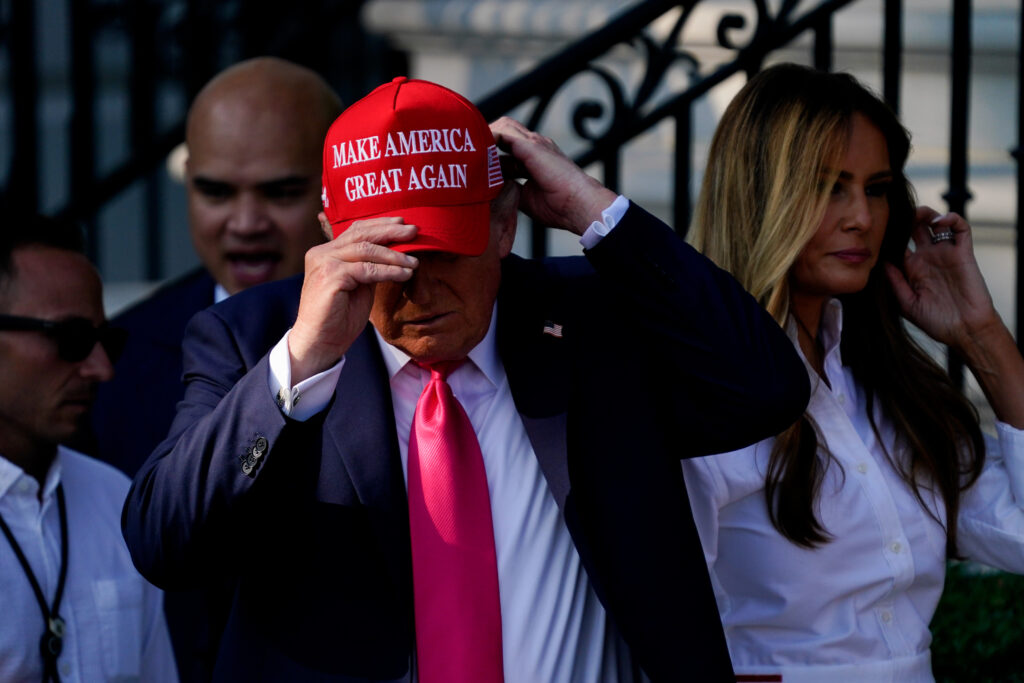New York Correspondences / Political and Geostrategic Observatory of the United States
26 August 2025
Trump: The Summer of (Almost) Every Triumph … Before a Potemkin Fall Season

The summer of 2025 will be remembered as Donald Trump’s near–grand slam—his diplomatic, political, judicial, and symbolic victories sketch the contours of a new order where might prevails over right. At home and beyond.
The “Chief Diplomat”
On June 27, in Washington, a peace agreement between Rwanda and the Democratic Republic of Congo was signed, aiming to end decades of conflict. Added to this were the easing of tensions between India and Pakistan and a rapprochement between Azerbaijan and Armenia. Trump claimed credit: according to him, he had “stopped six wars” since his return to power. However fragile, though sometimes quite real, these successes grant him, in the eyes of his electorate and of certain heads of state and government, the stature of peacemaker, which he brilliantly exploits. In a world where Salman Rushdie never received the Nobel Prize for Literature, the Nobel Peace Prize might no longer be an impossible dream for Donald Trump.
But the sequence shifted when he abruptly abandoned the path of negotiations with Iran and reverted to “hard power.” On June 21, three Iranian nuclear sites were struck—including Fordow, hit by a massive bombing raid. Cast as preventive, this spectacular operation convinced part of the American public that their president had mastered the art of war as well as peace, and above all, that he could bend an enemy without dragging the country into one of those endless conflict —Iraq, Afghanistan— that had weighed down his predecessors.
A Supreme Court Under Orders
On the domestic front, Trump’s judicial strategy, following the taming of the Justice Department a few months ago, reached its peak. Since June, the Supreme Court has been multiplying rulings validating his most controversial initiatives. Even more radical: it drastically limited the ability of federal judges to block presidential decisions at the national level. An institutional upheaval that further weakens the separation of powers.
Congress, for its part, hardly resentful of seeing some of its prerogatives trimmed to the benefit of the White House, easily passed the One Beautiful Bill. The Democrats, more unpopular than they had ever been in thirty years, seem to have lost any ability to shape public debate. Even Barack Obama, who could have embodied a moral voice of opposition, seems too busy promoting books via Oprah Winfrey’s book club. Universities, several of whose departments are now under trusteeship, are capitulating one by one—even Harvard, which has finally “rolled over,” to use the words of conservative media.
A normalized state of exception
The deployment of the National Guard in Los Angeles was hailed far beyond Trump’s base. Buoyed by this precedent, the Trump/Vance administration took control of Washington, D.C., where tanks now stand in front of Union Station, the capital’s central railway hub, and announced the dispatch of federal troops to New York and Chicago. This gradual militarization of public space, presented as a response to “urban disorder,” is methodically installing a semi-authoritarian regime that barely bothers to disguise its name. The war against “wokeism” and the “woke elites” also seems on the verge of being won. Major corporations, which only yesterday trumpeted diversity in all its forms, now reject it without shame. LGBTQIA+ communities are ostracized, public media shut down or muzzled, pop culture figures pushed aside. Stephen Colbert and The Late Show were taken off the air after the host dared to criticize a deal concluded between the 47th president of the United States and Paramount, producer of the show. More symbolic still was the direct offensive against the Smithsonian Institution and its museums, accused, among other grievances, of giving the impression that “everything was horrible about slavery.” This cultural revisionism, pursued at full throttle on the eve of the nation’s 250th anniversary celebrations and facing no real opposition, illustrates the scale of the ongoing ideological overhaul.
The New Emperor of the West
On July 27, in Scotland, Donald Trump, between rounds of golf, extracted a trade deal with the European Union that will remain one of Brussels’ greatest diplomatic humiliations. Ursula von der Leyen accepted a text imposing a minimum 15% tariff on most European goods, without reciprocity on U.S. imports, a capitulation denounced in several European capitals. More humiliating still for the close allies of the new Caesar, who had already swallowed plenty of insults at the last NATO summit: Emmanuel Macron, Friedrich Merz, and Keir Starmer were not even received on the White House steps by Trump when they visited on August 18, but by his chief of protocol.
They came, like schoolchildren seeking strength in numbers—or rather like the vassals they had become—to support Volodymyr Zelensky and plead for a European role in resolving the war in Ukraine. They were reduced to near-extras, whose “suggestions”—to use Trump’s own words—the American president was magnanimous enough to hear. A public belittling symbolically confirming the loss of influence of the so-called European “great powers” on the world stage.
That European leaders should seek to play a role in resolving the Ukraine–Russia conflict is self-evident. But should they not try to do so with a bit more dignity—the very dignity that would give them greater authority and therefore greater weight? Can one imagine General de Gaulle behaving this way, accepting such treatment?
And not to mention, on the very same day, an episode I found—albeit in another register—almost as mortifying as their February encounter: the meeting between Zelensky and Trump. This time, the all-powerful Trump had no reason to attack his Ukrainian counterpart. Fawning and affable, he nevertheless demeaned him by joking about his suit and treating him like a little boy. Zelensky, who must of course avoid angering the American head of state, nonetheless abased himself in a staggering manner when his host repeatedly insulted Joe Biden in front of him—the man who had, after all, supported Ukraine for nearly three years. Not even a token protest, not even a polite formula such as: “You will allow me, Mr. President, not to criticize an ally who has given us so much support.” One wonders then what became of BHL’s “Ukrainian Churchill”.
The Return of the Bismarckian Order
Finally, Donald Trump and Vladimir Putin’s Augst 15 meeting in Alaska, staged with great pomp and ceremony, marks a decisive victory for the international order the White House intends to impose. Certainly, no truly substantive progress on the war in Ukraine emerged—for now—but that was not the point. The 47th president’s main foreign-policy goal is clear: to finish off what remains of the multilateral system born in 1945, already moribund.
This meeting symbolically closed an 80-year era—just as the United Nations was celebrating its anniversary. For the first time since World War II, two empires sat alone to discuss the dismantling of a third country, without that country present, without the UN or any other international organization—save NATO—even mentioned, and openly trampling international law. Should it be reminded that Vladimir Putin is under an arrest warrant from the International Criminal Court? Of course, Washington does not recognize that jurisdiction, but Trump’s staging handed the Kremlin leader a spectacular rehabilitation. One can welcome the resumption of dialogue between Washington and Moscow. But the manner, the pageantry, the theatrics turned this moment into a triumph for the Russian autocrat.
In short, it was not merely a diplomatic summit, but a founding act: the proclamation of the official end of the multilateral order, and the triumph of the Trump doctrine—a return to exclusively bilateral power relations, where might once again becomes the only law, recalling with eerie precision 19th-century Europe and the early decades of the 20th.
A Potemkin Fall Season
Just days before Labor Day weekend—which in the United States marks the end of summer and the return to work—two cherries landed on the top Donald Trump’s summer cake. The first: an unprecedented drop in the immigrant population, reported by the Pew Research Center, which the most right-wing administration in U.S. history flaunted as proof of its effectiveness. After more than half a century of continuous growth, the number of foreign-born residents in the U.S. fell by one million between January and June, dropping to 15.4% of the total population from 15.8% six months earlier. The second: a resounding legal victory on August 21, before a New York appeals court, which overturned the $464 million fraud fine imposed in 2024—deemed “disproportionate” and contrary to the Eighth Amendment. Yes, the court confirmed that the New York billionaire and two of his sons had indeed committed fraud, but the president emerged vindicated in the eyes of his supporters, enough to denounce a witch hunt and claim triumph over the liberal establishment.
But beyond these punctual successes, the coming months promise to be far more perilous. The White House’s entire strategy rests on an already-cracked economic façade, despite growth that continues at a moderate pace. The employment figures touted by the government—in contradiction with those of the Bureau of Labor Statistics (BLS), which led to the firing of its director Erika McEntarfer—mask a social reality of widespread precarity and poverty wages for the majority. At the same time, inflation is rising again (2.7% in June), the tariffs imposed across the board weigh on production costs and the entire value chain, the federal deficit is projected to reach record levels (+$3.3 trillion over ten years), and household debt is nearing $18 trillion. The Federal Reserve, for its part, still refuses any monetary easing, to the great frustration of an executive that multiplies its pressure. As for the IMF, it now warns of a fragile dynamic: the combination of persistent inflation, exacerbated protectionism, and a growing fiscal imbalance could sharply slow activity by year’s end.
And the One Big Beautiful Bill mentioned earlier will hardly improve matters, especially for impoverished populations and the lower middle class, heart of MAGA nation. Enacted with great fanfare on July 4, this budget law provides, among other measures even Ronald Reagan would not have dared to dream of, permanent tax cuts for the wealthiest, deep cuts to Medicaid (with about 15 million people at risk of joining the more than 30 million Americans with no health coverage), food assistance (SNAP), education, and more. The administration justifies this shift by the need to “unleash the forces of capital” and transfer to the private sector what remains of a social state deemed inefficient.
The fall could well reveal that the foundations of the Trump edifice are less solid than they appear. Should the economy falter, the entire political project—both domestic and international—of Donald Trump and his heir apparent, JD Vance, could totter. And voters are notoriously unforgiving of economic failure, especially just months before the midterm elections. That is one reason why the administration is working so relentlessly to reshape the electoral rules—if not, for now, to lock down the system itself: redistricting, restrictions on mail-in voting favorable to Democrats, administrative hurdles to staying on the rolls, all while maintaining its Potemkin façade, even if that means firing uncooperative civil servants.
Romuald Sciora directs the Political and Geostrategic Observatory of the United States at IRIS, where he is an associate researcher. A Franco-American essayist and political scientist, he is the author of numerous books, articles, and documentaries, and regularly appears in international media to comment on current affairs. He lives in New York.

